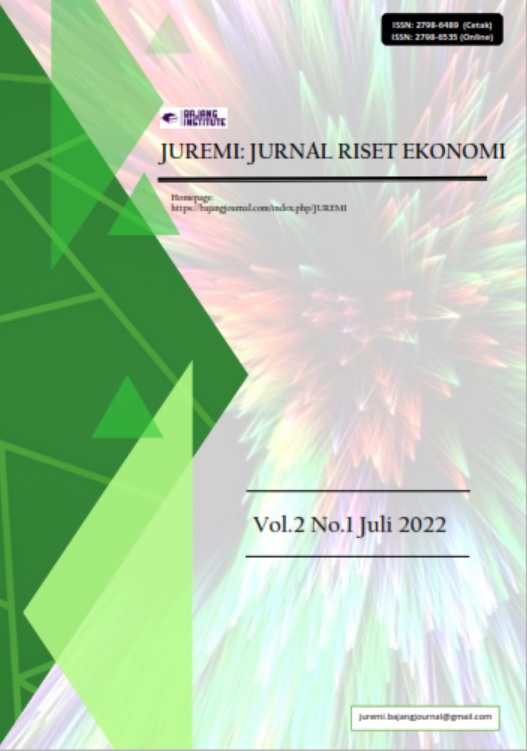ANALISIS MINAT MASYARAKAT MENGGUNAKAN APLIKASI HALO DOC DIMASA PANDEMI COVID-19
DOI:
https://doi.org/10.53625/juremi.v2i1.2692Abstract
The COVID-19 pandemic has had a considerable effect on the health sector, especially on health services. Restrictions on community activities outside the home are encouraged to deal with the spread of the COVID-19 virus. The use of health technology is currently being used as a solution for online health management, one of the applications used is Halodoc. This study aims to determine the effect of security, trust and convenience on public interest in using the Halodoc application during the COVID-19 pandemic. The measuring instrument used is a questionnaire distributed to the community using the Halodoc application in the Surakarta area, the sampling technique using purposive sampling and the Lemeshow equation so that a sample of 100 respondents is obtained. The analytical method used is multiple linear regression analysis.
The results of this study indicate that the security variable partially has a significant positive effect on interest with (p-value = 0.041) and a coefficient value of (0.185). The confidence variable partially has a significant positive effect on interest (p-value = 0.032) and the coefficient value is (0.220). The convenience variable partially has a significant positive effect on interest (p-value = 0.007) and the coefficient value is (0.368). Simultaneously, the security, trust and convenience variables have a significant influence on people's interest in using the Halodoc application (p-value < 0.001) with the contribution of the three variables being 62.5%.
References
Ghozali, I. (2016). Aplikasi Analisis Multivariate dengan Program IBM SPSS 23 (8th ed.). Semarang: Badan Peneribit Universitas Diponegoro.
Kholid, Fernanda Idham dan Embun Duriyani Soemarso. (2018). Analisis Pengaruh Keamanan, Kemudahan penggunaan, kepercayaan nasabah dan Kebermanfaatan terhadap Minat menggunakan E-Banking pada Bank BNI Syariah KCP Magelang. Jurnal Sains Ekonomi dan Perbankan Syariah, Vol.8, No.2, Hal.49-57. Mariah, &Kurniady. (2017). Analisis Faktor-Faktor Yang Mempengaruhi Jaminan Keamanan Dalam Transaksi Dengan Menggunakan Sistem E-Commerce Pada Bajiki Store Makassar. Pramana, Suprihartini, dan Wira. (2018). Pengaruh Keamanan, Harga, Kelompok Referensi, Dan Risiko Kinerja Terhadap Keputusan Pembelian Secara Online Mahasiswa (Studi Pada Mahasiswa Manajemen Universitas Maritim Raja Ali Haji Tanjungpinang Angkatan 2014).
Putri, dan Rochim. (2021). Hubungan Iklan Halodoc di Media Sosial terhadap Minat Viewers Menggunakan Aplikasi Halodoc. Bandung: Universitas Islam Bandung.
Saraswati, A, N. (2021).Pengaruh Persepsi Kemudahan Dan Persepsi Keamanan Terhadap Minat Penggunaan E-Money Di Kalangan Generasi Millenial(Studi Pada Masyarakat Kecamatan Medan Baru). Sumatera : Universitas Sumatera Utara.
Saripudin.,& Faihaputri, N. (2021). Pengaruh Kepercayaan, Keamanan, Dan Kemudahan Penggunaan Aplikasi Terhadap Minat Beli Ulang (Studi Kasus Di E-Commerce JD.ID). Edunomika – Vol. 05, No. 02 (2021). https://jurnal.stie-aas.ac.id/index.php/jie/article/download/2765/pdf
Sugiyono. (2016). Metode Penelitian Kuantitatif, Kualitatif, dan R&D. Bandung: Alfabeta.
Sukmarini, A, D., & Hasanah, M, N. (2021). Faktor yang Mempengaruhi Minat Mahasiswa Menggunakan Aplikasi Kesehatan di Masa Pandemi Covid-19. Urban Communication and Development Journal 2021; 1; 2. http://publication.rre-center.com/index.php/ucdj
Sunyoto, Danang. (2016). Analisis Regresi Dan Uji Hipotesis. Yogyakarta: CAPS.
Utami. (2021). Pengaruh Kepercayaan, Kegunaan, Keamanan Terhadap Minat Menggunakan Mobile Payment Linkaja Dengan Kemudahan Sebagai Variable Mediasi (Studi pada Mahasiwa di Yogyakarta). Jurnal Ilmiah Manajemen Kesatuan Vol. 9 No. 2, 2021. https://jurnal.ibik.ac.id/index.php/jimkes/article/view/554
















